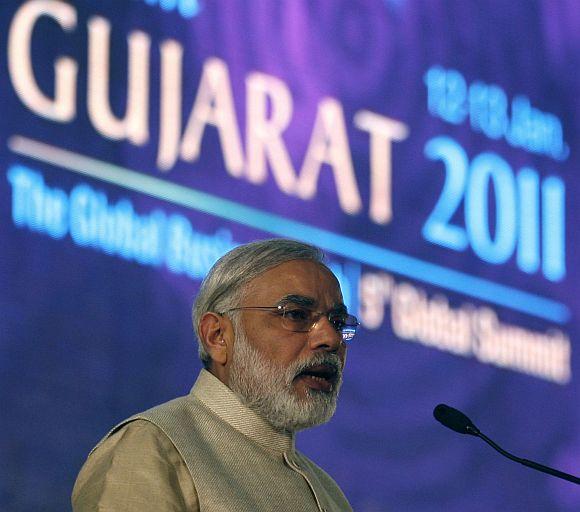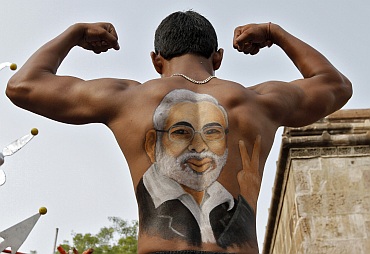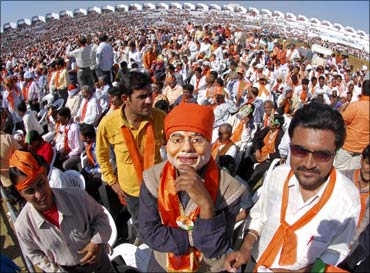
Observers say Modi’s speed, skill and scale mission has been supported by a well-oiled state machinery. Mayank Mishra reports
Narendra Modi rarely fails to mention the importance of three S -- skill, scale and speed -- in most of his speeches. While addressing the students of Delhi’s Shri Ram College of Commerce this year, he said: First, we should concentrate on skill development. Second, our scale must be large and, three, our speed must be fast. Skill, scale and speed: We must excel in these three things.
The fascination for scale started with the first Vibrant Gujarat Summit, in 2003. There have been six editions of it, each surpassing the preceding one in number of investment agreements signed and value of proposals received. Other states have own versions of such summits. But none can match these in terms of scale, signing of agreement, proposals and the attention it gets, says an Ahmedabad-based political analyst.
Modi’s fascination with scale and speed
Modi’s scale obsession is visible in many mega projects, in various stages of execution. One such is the Gujarat International Finance Tec-City, or GIFT. Inspired by the Shanghai model, GIFT, once fully operational, is supposed to replace Mumbai as the country’s financial hub. On 900 acres in an area between Gandhinagar and Ahmedabad, with an estimated investment of Rs 78,000 crore, the proposed hub is supposed to create a million jobs by 2020. It is different, though, that the project is yet to catch the fancy of the wizards of the financial world. Occupancy, as a result, is less than 10 per cent in the two completed commercial towers.
Another mega project is the 800-sq-km Special Investment Region at Dholera. There are six such SIRs in the pipeline. Each is to be a complete city, with an administrative structure and labour laws. Modi has a long-term vision, says psephologist and Bharatiya Janata Party leader G V L Narasimha Rao.
Another hallmark of the Modi regime has been speed. So impressed was the then chairman of Tata Group, Ratan Tata, with the speed of decision making that he decided to shift his stuck Tata Nano factory from Singur in West Bengal to Gujarat’s Sanand. The state does not come in the way of business decisions, says Anil Gupta, professor at the Indian Institute of Management, Ahmedabad.
...

Modi’s speed and scale mission has been supported by a well-oiled state machinery, say observers. Modi should be marketing his administrative model, rather than his development model. One of the first things he did as the chief minister was to install swipe machines at government offices to mark attendance. That single decision ensured regular attendance. Government offices in the state operate like corporate offices, with responsibility fixed and timely delivery as the core area, says the political analyst. What keeps government officials on their toes is Modi’s system of directly taking feedback from people on service delivery.
What is Modi’s alternative blueprint, apart from speed and scale? He wants a robust growth engine, to be supported by the three powerful pillars of manufacturing, services and agriculture -- he claims this has been the case in Gujarat. He wants flexible labour laws and is a supporter of foreign direct investment in defence production. He favours adoption of what he calls the Gujarat model of people-public-private participation, instead of the more familiar PPP mode. As for the government, his advice is -- move from government to governance. From rules and acts to responsible action. Only then will it be P2-G2: Pro-People, Good Governance.
The decision making might be faster and doing business in the state easier during Modi’s tenure. But has the process been democratic? The opinion is clearly divided. D L Sheth, political scientist and former director of the Centre for the Study of Developing Societies, says authoritarian tendencies are quite visible in Modi. Scores of leaders like Keshubhai Patel, Shankarsinh Vaghela and Sanjay Joshi either left the party or were marginalised. Police officers like Kuldeep Sharma, Rahul Sharma, Sanjiv Bhatt, R B Shreekumar and Rajnish Rai were in the line of fire.
...

Some commentators have compared Modi with Indira Gandhi’s style of functioning. Social historian Ramachandra Guha has argued in his column that, like Indira Gandhi, Modi seeks to make his administration an extension of his personality. Social scientist Shiv Vishwanathan, however, says Modi’s authoritarianism is different from Gandhi’s. While Gandhi’s authoritarianism was of the Mother India variety, populist and nationalistic, Modi’s is technocratic, driven by the notion of a swadeshi masculine nation.
Rao is dismissive of such description. He says Modi is a decisive leader, who does not believe in the politics of convenience and finds the politics of appeasement reprehensible. He goes on to say Modi, on the contrary, delegates a lot and allows ministers and officers to innovate and experiment and take responsibility. At the annual chintan baithak, all government officials freely share their ideas and are encouraged to implement these, says Rao.
What has made Modi the way he is? Call it decisive, strong or authoritarian. A long innings with the RSS, where he learnt all his organisational skills? A trip to the Himalayas, where he spent a few years before becoming a fulltime volunteer of the RSS?
Incidentally, the mercurial founder of Apple, Steve Jobs, spent seven months in the Himalayas around the same time before launching the company. On his experience, Jobs told his biographer, Walter Isaacson, that the people in the Indian countryside don’t use their intellect like we do, they use their intuition instead, and their intuition is far more developed than in the rest of the world. Intuition is a very powerful thing, more powerful than intellect, in my opinion. That’s had a big impact on my work. Is Modi also driven by intuition?
Some have a simpler explanation. Many successful politicians following Indira Gandhi have used the same formula as she did. Modi is one of them. He has taken a few pages out of Indira Gandhi’s book, says Anand Kumar, professor of sociology at JawaharlalNehruUniversity.
...